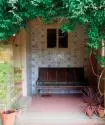Cultivating Standen
 Written by Cynthia Shaw for the Colorado Arts & Crafts Society
Written by Cynthia Shaw for the Colorado Arts & Crafts Society
Photos Courtesy of John H. Waters
Crafted in 1892-94 for a wealthy London solicitor, James Beale, his wife Margaret and their seven children, Standen exemplifies architect Philip Webb’s love and celebration of skilled craftsmanship, vernacular materials and family life. An avid proponent of “anti-scrape” (an ideal that spawned the creation of SPAB, Britain’s Society for the Protection of Ancient Buildings), he masterfully melded the existing 15th century Great Hollybush farmhouse and other agrarian structures into his dream of domesticity giving them a new lease on life as part of a contiguous compound for the ever-expanding Beale clan.
 With its exterior of handpicked local sandstone and brick, accentuated with hanging tiles and oak weatherboarding, the house blended harmoniously with its site against a hillside offering sloping views of Margaret’s experimental garden, nearby meadows and distant forest. Webb gave the same attention to detail to the interior, with meticulous consideration lavished on the comfort of the occupants: light-filled rooms graced with Morris wallpaper and fabric, art pottery and cozy Victorian furniture (with later additions from Morris & Co.). The result was a pervasive sense of “heaven on earth” that not only delighted the family from the moment they moved in, but continues to cast its spell on subsequent visitors (take a look at some of the handiwork samples casually placed in some of the rooms and you’d swear the Beale sisters have simply stepped out for some afternoon tea).
With its exterior of handpicked local sandstone and brick, accentuated with hanging tiles and oak weatherboarding, the house blended harmoniously with its site against a hillside offering sloping views of Margaret’s experimental garden, nearby meadows and distant forest. Webb gave the same attention to detail to the interior, with meticulous consideration lavished on the comfort of the occupants: light-filled rooms graced with Morris wallpaper and fabric, art pottery and cozy Victorian furniture (with later additions from Morris & Co.). The result was a pervasive sense of “heaven on earth” that not only delighted the family from the moment they moved in, but continues to cast its spell on subsequent visitors (take a look at some of the handiwork samples casually placed in some of the rooms and you’d swear the Beale sisters have simply stepped out for some afternoon tea).
For 70 years, Standen served as home base for several generations of Beales (while most of the children had married or moved away by the turn of the century, they all returned regularly with their offspring for festive family gatherings or just plain “roamin’ in the gloamin’”. After James died in 1912, Margaret and two unmarried daughters ran the estate. Before her death in 1972, Helen Beale asked The National Trust to take over the property. Standen – an early model of adaptive re-use and a modern day example of sustainable stewardship – has been deftly managed ever since as a testament to Philip Webb’s version of “Life in the English Country House”.
Next week we’ll be focusing on Webb’s more famous work The Red House, so stay tuned!
For more information on the Colorado Arts & Crafts Society, please visit coloarts-crafts.org.

